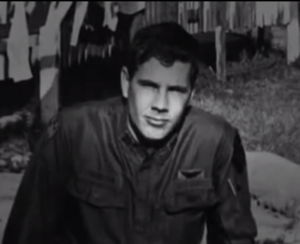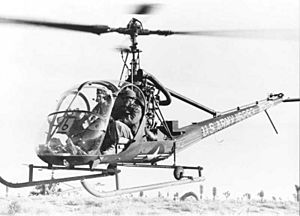Hugh Thompson Jr. facts for kids
Quick facts for kids
Hugh Clowers Thompson Jr.
|
|
|---|---|

Hugh Clowers Thompson Jr. in 1966
|
|
| Born | April 15, 1943 Atlanta, Georgia, U.S. |
| Died | January 6, 2006 (aged 62) Pineville, Louisiana, U.S. |
| Allegiance | United States of America |
| Service/ |
|
| Years of service | 1961–1964 (United States Navy) 1966–1983 (United States Army) |
| Rank | Major |
| Unit | Naval Mobile Construction Battalions 2nd Battalion, 123rd Aviation Battalion, 23rd Infantry Division |
| Battles/wars | Vietnam War |
| Awards | Soldier's Medal Distinguished Flying Cross Bronze Star Medal Purple Heart Air Medal |
Hugh Clowers Thompson Jr. (born April 15, 1943 – died January 6, 2006) was a brave United States Army Major. He is remembered for his heroic actions during the Mỹ Lai Massacre in Vietnam on March 16, 1968. Along with his crew members, Glenn Andreotta and Lawrence Colburn, Thompson helped stop the killing of unarmed Vietnamese civilians.
During the massacre, Thompson and his helicopter crew saw American soldiers harming civilians. They bravely landed their helicopter and stood between the soldiers and the villagers. Thompson even threatened to fire on the American soldiers if they continued their attacks. He and his crew saved many Vietnamese people by helping them escape and arranging for them to be flown to safety.
Thompson reported the terrible events by radio multiple times. Even though his reports reached military headquarters, nothing was done right away. After taking a wounded child to a hospital, Thompson angrily told his superiors that a massacre was happening. Because of his report, the military leaders finally ordered all ground units to stop the violence in the village.
In 1970, Thompson spoke out against those responsible for the Mỹ Lai Massacre. Many soldiers were charged, but most were not punished. Thompson faced criticism from some people in the military and the public for speaking up. Despite these challenges, he stayed in the United States Army until 1983.
In 1998, 30 years after the massacre, Thompson and his crew members, Andreotta (who died earlier) and Colburn, received the Soldier's Medal. This is a very high award for bravery that does not involve fighting the enemy directly. Thompson and Colburn returned to Vietnam in 1998 to meet with some of the people they had saved.
Contents
Early Life and Military Service

Hugh Clowers Thompson Jr. was born on April 15, 1943, in Atlanta, Georgia, United States. His father was an electrician and served in the United States Navy during World War II.
In 1946, Thompson's family moved to Stone Mountain, Georgia. His brother, Tommie Norman Thompson, also served in the United States Air Force during the Vietnam War. Thompson was a member of the Boy Scouts of America. His family taught him to be disciplined and honest. They also stood against racism and helped many minority families in their community.
After graduating from Stone Mountain High School in 1961, Thompson joined the United States Navy. He worked as a heavy equipment operator. In 1964, he left the Navy and became a funeral director.
When the Vietnam War started, Thompson felt he needed to serve again. In 1966, he joined the United States Army. He trained to become a helicopter pilot. In late 1967, at age 25, Thompson was sent to Vietnam. He was assigned to the 23rd Infantry Division.
Stopping the Mỹ Lai Massacre
On March 16, 1968, Thompson and his helicopter crew were flying over a village called Sơn Mỹ in South Vietnam. Their job was to support a "search and destroy" mission. The U.S. Army thought this village was a stronghold for enemy fighters.
However, the information was wrong. The village was mostly filled with peaceful families who farmed rice. Thompson's helicopter flew over the area but did not receive any enemy fire. Despite this, the U.S. Army shelled the village, killing many civilians. After the shelling, American soldiers entered Sơn Mỹ.
As the soldiers moved through the village, they began killing unarmed civilians, mostly women and children. They also set fire to huts.
Thompson saw an irrigation ditch full of dead and wounded civilians. He also saw a group of women, children, and old men trying to escape from the soldiers. Thompson quickly realized the soldiers planned to kill these villagers too. He bravely landed his helicopter between the soldiers and the civilians.
He told his crew members, Lawrence Colburn and Glenn Andreotta, to point their guns at the American soldiers. He ordered them to shoot if the soldiers tried to harm any more civilians. While his crew watched the soldiers, Thompson gathered as many civilians as he could. He convinced them to follow him to a safer place. He then arranged for two other helicopter pilots, who were his friends, to evacuate the civilians by air.
Thompson's helicopter was running low on fuel, so they had to leave the village. Before they left, Andreotta saw movement in the ditch filled with bodies. They pulled a wounded child, Do Ba, from the ditch. After finding no other survivors, Thompson's crew took the child to a hospital.
After dropping off the child, Thompson flew to his headquarters. He angrily reported the massacre to his commanders. His report quickly reached Lieutenant Colonel Frank Barker, who was in charge of the operation. Barker immediately radioed the ground forces and ordered them to stop the killings. After refueling, Thompson's crew returned to the village to make sure no more civilians were being harmed and that the wounded were rescued.
After the Massacre
Thompson made an official report about the killings. Senior officers in the American military then canceled similar planned operations against other villages. This likely prevented hundreds, or even thousands, more Vietnamese civilians from being killed.
At first, military leaders tried to hide the Mỹ Lai massacre. Thompson quickly received the Distinguished Flying Cross for his actions. However, the award description was not true. It praised Thompson for taking a child to a hospital who was "caught in intense crossfire." It also said his actions "greatly enhanced Vietnamese–American relations." Thompson threw away the award paper because it was false.
Thompson continued to fly missions and was hit by enemy fire eight times. In four of those times, his helicopter was destroyed. In the last incident, his helicopter was shot down, and he broke his back in the crash. This ended his combat duty in Vietnam. He was sent to a hospital in Japan for a long recovery.
When news of the massacre became public, Thompson shared his story again with military investigators. In late 1969, he was called to Washington, D.C., to speak to a special hearing. Some congressmen criticized him sharply. They wanted to downplay the massacre. One congressman even said Thompson should be punished for threatening fellow American troops.
Thompson faced strong criticism from many Americans for speaking out against U.S. Army personnel.
After his service in Vietnam, Thompson became a flight instructor. He later became a captain and then retired as a major. He retired from the army in 1983.
Life After the Military
After leaving the military, Thompson became a helicopter pilot for the oil industry in the Gulf of Mexico. In 1988, a documentary filmmaker from England, Michael Bilton, found Thompson. Thompson had mostly stayed out of public view. Bilton also connected Thompson with his former crew member, Lawrence Colburn, after nearly 16 years.
Both Thompson and Colburn were interviewed for a film called Four Hours in My Lai (1989). In the interview, Thompson shared what he saw at Mỹ Lai. He said, "Here we were supposed to be the guys in the white hats. It upset me." This film helped bring attention to their story.
In 1998, Thompson and Colburn returned to the village of Sơn Mỹ. They met some of the people they had saved during the killings. Thompson told the survivors, "I just wish our crew that day could have helped more people than we did." One of the women they had helped asked him why the people who committed the acts did not come back. She then finished her sentence by saying, "So we could forgive them." Thompson later said he was not strong enough to forgive them himself. Thompson and Colburn lit incense sticks at a memorial stone where many were killed. They also helped dedicate a new elementary school for the village children.
Thompson later worked as a counselor for veterans in Louisiana. He gave talks at military academies about military ethics and courage. His actions have been used as an example in ethics training for military forces in the U.S. and Europe. In 2005, he retired from his work with veterans.
Recognition for Actions at Mỹ Lai
In 1998, exactly 30 years after the massacre, Thompson and his crew members, Glenn Andreotta and Lawrence Colburn, received the Soldier's Medal. This is the highest U.S. Army award for bravery not involving direct fighting with the enemy. At the ceremony, Major General Michael Ackerman said the three men "set the standard for all soldiers to follow." Senator Max Cleland also honored them in the U.S. Senate, calling them "true examples of American patriotism."
In 1999, Thompson and Colburn received the Peace Abbey Courage of Conscience Award. They also helped lead a group that pulled a one-ton rock engraved "Unknown Civilians Killed in War" from Boston to Arlington National Cemetery. The Hugh Thompson Foundation was created in 2010 to remember Thompson's courage. A book about him, The Forgotten Hero of My Lai: The Hugh Thompson Story, was added to the U.S. Army Chief of Staff's reading list.
Many artists have created works inspired by Thompson's actions. Folk singer David Rovics wrote a song called "Song for Hugh Thompson." Jonathan Berger composed a piano concerto dedicated to Hugh Thompson. This music was performed at the United Nations General Assembly in 2001.
Death
Hugh Thompson Jr. died on January 6, 2006, at the age of 62, after battling cancer. He passed away at the Veterans Affairs Medical Center in Pineville, Louisiana. Lawrence Colburn, his crew member, was with him. Thompson was buried in Lafayette, Louisiana, with full military honors. These honors included a three-volley salute and a helicopter flyover. On February 8, Congressman Charles Boustany honored Thompson in Congress, saying that the "United States has lost a true hero."
See also
 In Spanish: Hugh Thompson Jr. para niños
In Spanish: Hugh Thompson Jr. para niños
- Seymour Hersh
- Silas Soule
- William Calley
Images for kids



